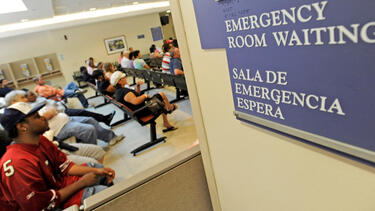In the Emergency Department, Patients from Marginalized Groups Are More Likely to be Bypassed in the Queue
In a busy hospital emergency department, White people who speak English and have private insurance often get seen faster, according to new research from Professors Lesley Meng and Edieal Pinker and Dr. Rohit Sangal ’21 of Yale New Haven Hospital. The researchers say that systemic changes are needed to eliminate this disparity.

Even in the best of times, a hospital emergency department (ED) is an environment of controlled chaos. Patients come in at irregular intervals with a wide range of symptoms, from a bloody finger to cardiac arrest. There’s only a limited number of rooms. Who gets to see the doctor first and who will have to wait, sometimes for hours?
“The crowding in EDs is an increasing trend over the last decade,” says Rohit Sangal ’21, an ED physician at Yale New Haven Hospital and a graduate of Yale SOM’s MBA for Executives program. One contributing factor, he says, is primary care physicians and specialists who send patients to the emergency department to access imaging and other services that are not readily available in the outpatient setting. Another is the general overcrowding of hospitals. “In inpatient units, particularly those caring for older and sicker patients, patients have longer stays. And when there’s no space in inpatient units, it backs up to the ED.”
Most EDs use a triage system to contain the chaos. When a patient checks in, the triage nurse rates their condition on a scale of 1 to 5, with 1 being the most serious. Within each group, patients are placed in treatment spaces first come, first served.
At least in theory. Stick around an ED waiting room, and you’ll notice that it doesn’t always work that way. Sangal noticed that some people seemed to jump the line and get seen by a doctor sooner than other people with similar ailments even though they checked in later. These line-jumpers seemed to fit the same demographic profile: White people who speak English.
While Sangal was studying at Yale SOM, he took a class with Edieal Pinker, the BearingPoint Professor of Operations Research, who has an interest in healthcare systems. Pinker introduced Sangal to Professor Lesley Meng, and the three of them, along with colleagues from the Yale School of Medicine, Yale New Haven Hospital, and Yale’s Center for Outcomes Research and Evaluations, launched a study based on Sangal’s observations of how social inequities affect the flow of patients through the ED.
The researchers worked with a large dataset encompassing 314,763 patient visits to two EDs at a large academic medical center between July 2017 and February 2020, before the onset of the COVID-19 pandemic. “It was very large and very messy,” says Meng. “We worked with Rohit to extract the data and make sense of it.”
The first thing they had to do was prove that the inequalities truly existed and couldn’t be explained by other factors. The Yale SOM team members shadowed Sangal and his ED colleagues to see how they did their work. With Huifeng Su, a Yale SOM PhD student, they used multiple data pulls, double-checked date stamps, and compared data on both a large and granular scale.
They found that Black and Hispanic patients, non-English speakers, and people on Medicaid (who tend to have a lower income) were indeed more likely to be passed over than White English-speakers with private insurance. The passed-over patients were also more likely to be placed in a hallway treatment space and leave without being seen or even completing their care.
There are several possible explanations for these disparities. Some are bureaucratic: Patients with less access to a primary care physician are also less likely to have complete medical records on file. “If the ED had more information,” says Sangal, “they might get a different score.”
There are also language issues: People who are fluent in English may feel more comfortable advocating for themselves and convincing ED staff to bump them ahead in the line.
And some of it may be simple human error. The people doing triage are often overworked and stressed. However, as Pinker notes, “the mistakes seem to go in one direction” — that is, in favor of the patients with more socioeconomic advantages.
The researchers didn’t set out to eliminate ED queue-jumping altogether. Sometimes it’s necessary: medical conditions, especially in the ED, can change quickly. But, they say, changes are needed to eliminate the systemic bias in queue-jumping.
One way to do that is to change the way the ED triage system works. Instead of one big pool of patients waiting for rooms, for instance, there could be several. Nurses could be authorized to do tasks that are normally reserved only for doctors. ED staff could check up more frequently on patients, especially those who may have a harder time communicating or are less likely to advocate for themselves.
Now that the initial study’s been done, says Pinker, it should be easy for others to replicate it and test different solutions. “Most hospitals have similar data,” he continues, “and they can use what we did as a blueprint. They can say ‘We also have this issue and we tried this intervention.’ Or if some find they don’t have that issue, why don’t they? That’s the purpose of doing research and publishing it, to try to advance all of critical care.”
Sangal, Meng, and Pinker, meanwhile, are currently working on a study about what happens once a patient leaves the ED and is admitted to the hospital.
“Every stop along the way is a place that needs to get studied,” says Pinker, “and we’re studying them all.”